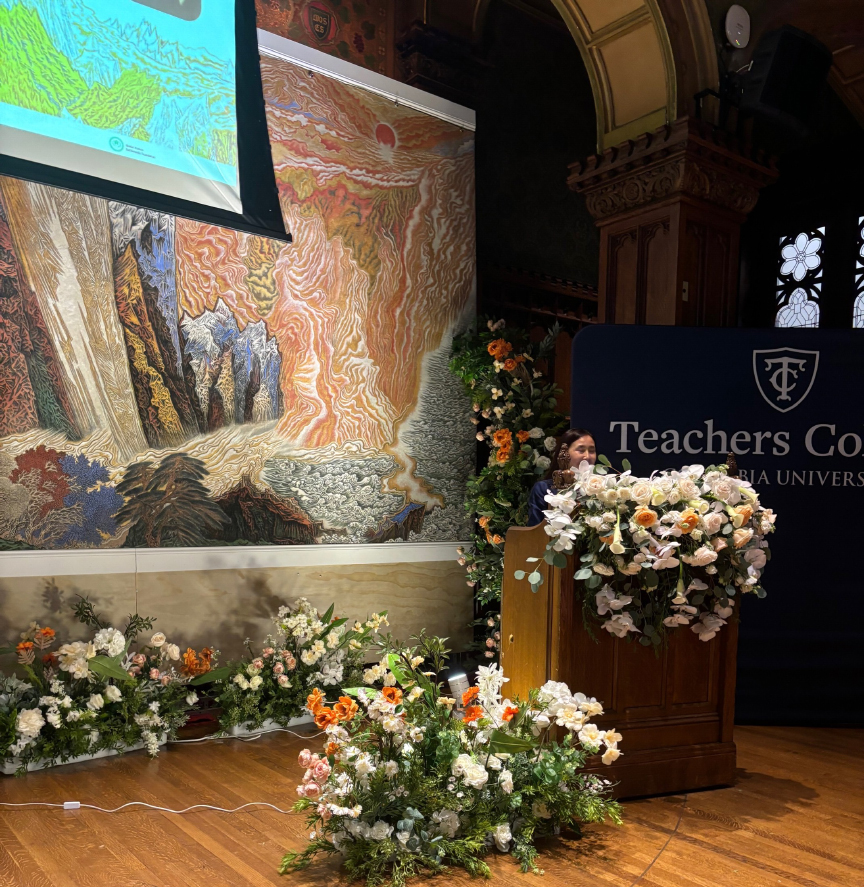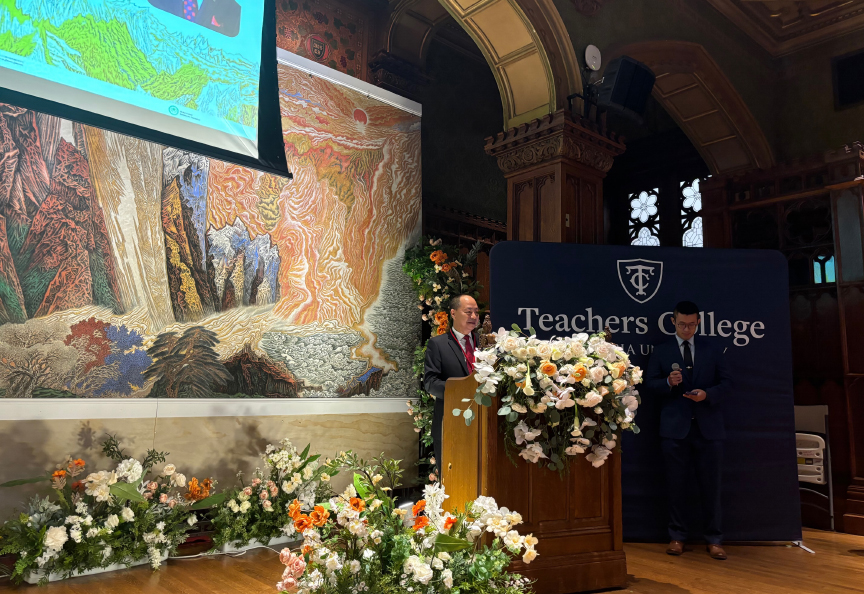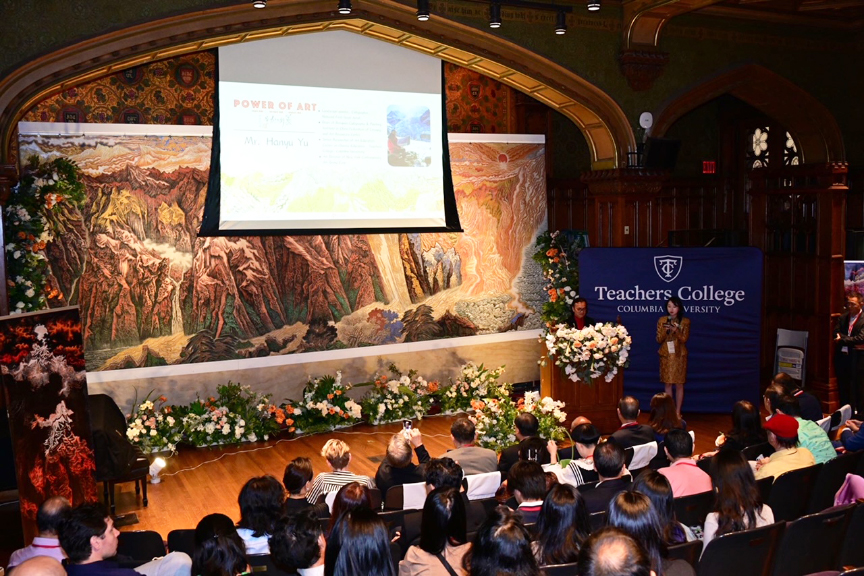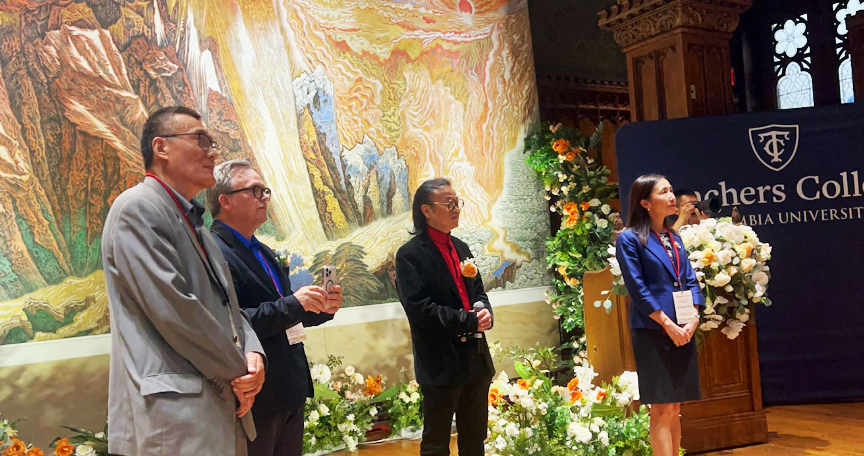|
|
||||||||||
Center on Chinese Education , Teachers College, Columbia University |
2:00 pm - 5:00 pm / Aug 18, 2024 |
Milbank Chapel, Teathers College, Columbia University |
525 W. 120th Street, New York, NY 10027 |
Co-Chairman of the Event Committee: Prof. Henan Cheng, FNU OUDOM |
Vice-Chairman and Secretary General of the Event Committee : Prof. Frances Zhao |
Curator: Prof. Gan Yu; Co-curator:Ethan Cohen |
|
The earliest discovered murals in ancient Greek palaces, dating back to 1500 BCE, have a history of more than 3,500 years. Like language, writing, music, and dance, this form of visual art is a vital part of human civilization. These skills have continuously evolved through teaching and education. Art reflects the soul, and education shapes the soul. When the two merge, they can generate immense power. The "Power of Art: Creation, Cultivation, Dedication" Art and Education Academic Symposium and "Sacred Realm of the Mind" Yu Hanyu Painting and Calligraphy Exhibition, organized by the Teachers College, Columbia University provided an engaging dialogue and exploration of art and education for the faculty, students, and audience. This event combined Columbia University's unique academic prestige, with organizers and artists collaborating to participate in the interdisciplinary discussion and dissemination of cultural art. It not only attracted art enthusiasts but also fostered discussions on traditional art and appreciation of Asian art among faculty and students from different fields, highlighting the educational and cultural significance of the exhibited works. Throughout human history, art and education have always been closely related. The advancement of human civilization and the development and evolution of culture and thought are inseparable from art and education. Since ancient times, art has been a means of education. In medieval Europe and Asia, religious paintings and sculptures were used as language and writing to educate believers, narrating doctrines and religious stories. Numerous examples can be seen in the murals of European medieval churches and the murals of the Dunhuang caves in China. As human civilization progressed, the relationship between art and education became even closer and inseparable. The master-apprentice system of the past and the modern art schools are forms of education that nurture talents. The visual aesthetics created by artists serve society, embodying the sublimation of education. This exhibition introduces the audience to a significant art form in the history of Chinese art: the heavy-color painting style. Before the Wei and Jin Dynasties, Chinese painting predominantly featured heavy-color figures, such as the Kizil murals and the Dunhuang murals. It was only after the Sui and Tang Dynasties that independent landscape painting emerged. In landscape painting, there are distinctions between heavy-color and ink painting. The heavy-color painting includes two forms: blue-green heavy color and gold-blue heavy color. The gold-blue heavy color is characterized by its brilliant golden light, grandeur, and auspiciousness, with a large amount of pure gold powder used in its creation. It was exclusively appreciated by emperors after the Tang and Song Dynasties, collected, appreciated, and displayed in the royal palaces. The ordinary people could only collect and appreciate the blue-green heavy-color paintings without gold embellishments. Yu Hanyu's exhibition piece "Sunrise in the East" belongs to the gold-blue heavy-color painting style. This work geographically depicts the grand mountains and rivers extending from northwest to southeast China along an axis, from left to right: Kunlun Snow Mountain and glaciers, Qinling Snow Mountain, the Yellow River, Mount Tai, and finally into the sea. "Sunrise in the East" is rooted in tradition yet distinct from it. The coloring method uses traditional gold-blue heavy-color techniques and also incorporates and utilizes the color relationships of Western oil painting. The brush and ink structure of the entire painting is derived from the unique geographical features of snow mountains and glaciers in the Northwestern landscape of China, something not seen in traditional Chinese paintings, making it a valuable new research theme. "Sunrise in the East" is an artist's portrayal of nature through brushstrokes, where the strokes themselves serve as both medium and substance. The piece depicts not only the objective landscape but also the scenery of the artist's mind. Viewers can feel the critical moments of energy and matter transformation in the artworks: the moment when matter is about to purify into energy, representing both destruction and creation. This exhibition organized by the Teachers College of Columbia University presents a meaningful academic topic to the audience: "What is the relationship between art and education?" The soul and forms of art need to be passed on and sublimated through education. "Sunrise in the East" demonstrates the power of visual art not only through the massive sizes but also as the crystallization of artist’s long-term learning and practical experience. For education, incorporating art into pedagogy can not only expand students' literacy but also stimulate their imagination and creativity through art's visual characteristics, enhancing their cognitive and problem-solving abilities. An exhibition is indeed a visual essay that, while showcasing and appreciating art, educates and elevates both the artist and the audience. In today's digital and AI era, the widespread use of tools like ChatGPT poses a significant challenge to original handmade art. How painting, as one of the oldest human crafts, can inherit and develop traditional skills and pass on the "craftsman spirit" accumulated over a thousand years in the new technological era is already an important issue. The exhibition and symposium "The Power of Art: Creation, Cultivation, Dedication" raises these questions for everyone to ponder and explore, hoping that Columbia University teachers and students will bring more suggestions, inspiration and answers to artistic creation. (Article by Dr. Gan Yu)
|
哥伦比亚大教育学院 艺术的力量 : 创造、培育、奉献 艺术与教育学术研讨会暨 “ 心象圣境 ” 余涵宇书画作品展 2024 年 8 月 18 日 筹备委员会主席:程贺南教授 / 帆 . 伍东教授 ; 筹备委员会副主席兼秘书长: Frances Zhao教授 策展人 : 喻干教授; 联合策展人 : 一森 科恩先生 |
| . |
最早发现的公元前1500 年古希腊皇宫壁画至今已有 3500 年的历史,这种视觉艺术形式和语言、文字、音乐、舞蹈一样,是人类文明的重要组成部分,这些技能都是通过传授和教育不断发展至今 。 艺术反映灵魂,教育塑造灵魂,当二者相融合时就能产生巨大的力量。 哥伦比亚大学 教育学院主办的 “ 艺术的力量 : 创造、培育、奉献 ” 艺术与教育学术研讨会暨 “ 心象圣境 ” 余涵宇书画作品展 为哥大师生和 观众提供了一次精彩的艺术与教育的对话和探讨。这个 活动结合了哥伦比亚大学独特的学术声望,组织者与艺术家通力协作,跨学科参与文化艺术的研讨和传播。它不仅能吸引艺术爱好者,也与学校不同领域的师生共同促成对传统艺术的讨论和对东方绘画的欣赏,突显了所展出作品的教育和文化意义 。 在人类历史的发展中,艺术与教育一直是紧密相连的。人类文明的进步 、 文化与思想的发展和演化都离不开艺术和教育。自古以来艺术就是教育的一种手段,在中世纪的欧洲和亚洲,宗教绘画与雕刻被当作语言和文字来教育信徒,讲述教义及宗教传说与故事。我们可以从欧洲中世纪教堂壁画和中国敦煌石窟壁画中看到许多例子。随着人类文明的进展,艺术与教育的关系就更加紧密,不分你我。古时的师傅带徒弟和现代的艺术学院都是培养人才的教育形式 ; 艺术家所创造出的视觉审美奉 献社会, 是教育的升华 。 此展览向观众介绍中国美术史上的一种重要的艺术形式 : 重彩画艺术。魏晋以前,中国绘画以重彩人物为主,如克孜尔壁画和敦煌壁画,隋唐以后才出现独立的山水画。在山水画中,有重彩与水墨之分 ; 重彩画中有青绿重彩和金碧重彩两种形式。金碧重彩以其金光灿烂、 大气恢弘、富足吉祥为特点,再加上其大量勾填的纯金粉,为唐宋以后的历代帝王所专赏, 用以专门收藏、欣赏、展示于皇宫。民间只能收藏和欣赏没有勾填金色的青绿重彩画作。展览中余涵宇的《日旭东方》就是属于金碧重彩画的类型。该件作品在地理上表现从中国西北向东南沿着一条轴线展开的大山大河,从左到右依次为 : 昆仑雪山和冰川、秦岭雪山、黄河、泰山最后进入大海。 《日旭东方》的风格源于传统又有别于传统,上颜色用传统的金碧重彩的着色法,也参考和运用了西方油画的色彩关系,使色彩既传统又现代。整幅画的笔墨结构来源于西部山水的雪山冰川的特殊地理构造,在中国传统山水画里未见前人这样的表述,这是一个很具有研究价值的山水画新课题。 《日旭东方》 是艺术家在用笔描绘自然, 笔迹本身既是媒介又是物质 ; 作品所表现的既是客观风景和也是艺术家心灵的景色。观众能够从画面中感受到能量与物质相互转换的关键时刻:当物质即将纯化为能量时,也就是破坏和创造的瞬间。 哥伦比亚大学 教育学院主办的这个展览向观众展示了一个有意义的学术论题 : 什么是艺术与教育的关系 ? …... 艺术的灵魂和表现形式需要通教育来传播和升华, 《日旭东方》 展现给观众的不仅是由巨大尺寸而产生的视觉艺术的力量,它也是艺术家经过长期的学习和多年的实线后所得出的结晶。对于教 育来说, 把艺术引入 教学法 不但可以扩展学生们的素养,也能通过艺术的视觉特征激发学生们的想象力和创造力,提高他们的认知和解决问题的能力。 一个展览就是一篇视觉论 文 , 它在展现艺术作品和欣赏艺术作品的同时,使艺术家自己与观众一起受到教育,受到感染,受到提高。 在今天数字化和人工智能的时代, ChatGPT 广泛使用对手工艺术原创是一个严峻的挑战。作为人类最古老手艺活之一的绘画如何在继承和发展传统技艺,把千余年所积累起来的“工匠精神”在新科技时代薪火相传已经是一个重要的话题。 “ 艺术的力量 : 创造、培育、奉献 ” 研讨会 暨作品展 把 这些问题提出来供大家思考和探索,期待着哥伦 比亚大学师生们 给艺术创造带来更多的建议 、 启迪与答案。 ( 喻干博士撰文 ) |
|
|
|
We live with art 我们生活在艺术之中 |
|||||||
|
|
||||||||
本网站里所有网页设计的版权属纽约"中华文化艺术网" eChinaArt.com, Inc. 所有,文章、艺术作品照片版权属艺术家或作者本人所有。任何未经版权所有人许可的转载, 出版或借用都将被追究法律责任。eChinaArt.com,Inc© |
||||||||






